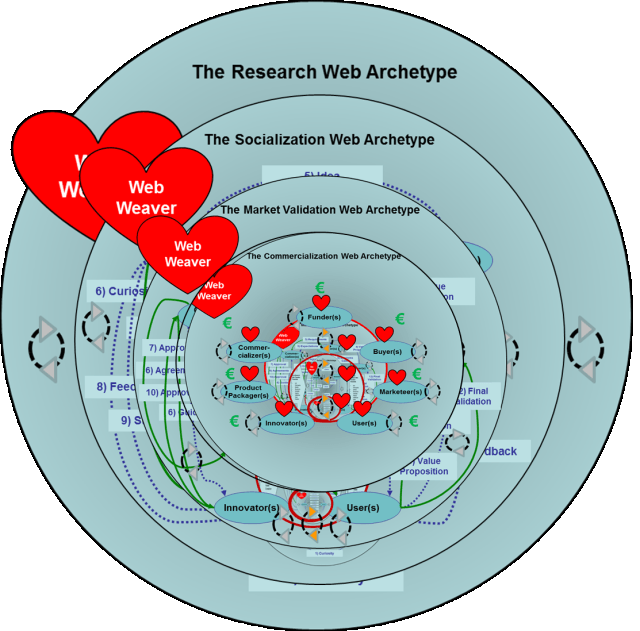Innovation Webs
Innovation Webs
ENTOV-HVM enables and increases the number of breakthrough scientific developments in high value manufacturing. This leads to new concepts, services and products and thereby contributes to bridging the research and innovation divide and participation gaps in Europe. This also strengthens European research and innovation capacities at individual, (sub-) group, enterprise, regional, intra- and international levels.
A simplified more operational view is provided by the “Narrative for Generic Diffusion of Innovation” which is also supported by the Litmus Test. Feel free to “short-circuit” the below details as desired!
Two activities related to visibility and survivals achieve this. The first activity significantly increases the number of related scientific developments that are visible to and mature enough for successful consumption by existing innovation acceleration / transfer mechanisms at local, regional, national and transnational level. The second activity accelerates the progress and survival rate of such scientific developments through the diffusion of innovation curve from ideation, through research, socialization, market validation and commercialization “in a heart-beat”.
By consciously serving its complex adaptive nature through the pivotal and novel role of “web weavers”, ENTOV-HVM uncovers and supports those true patterns of collaboration, which have continuously proven themselves over the course of history as archetypes for truly successful innovation. “Web weavers” are a trustworthy, deeply connected group of diverse world class game changers, at all career stages, from multiple disciplines with a passion for innovation and addressing industrial and societal challenges who exhibit intensive behavioural preferences of caring for, humility and openness towards, and curiosity in creating the space for breakthrough actionable and pragmatic opportunities in the public domain leading to measurable impacts on a wide range of relevant intellectual and financial capital within disruptively short periods of time. Web weavers are like a surgical dream-team who understand industry / research challenges, operate to create actionable solutions and deliver measurable impact.
The aspiration is enabling responsible innovation “in a heart-beat” at all levels of high value manufacturing. High value manufacturing is the application of leading edge technical knowledge and expertise to the creation of products, production processes, and associated services, which have strong potential to bring sustainable growth and high economic value. Activities hereby cover the complete circular product life cycle and are characterised by a combination of high research and development intensity and high growth. Innovation is the flow of knowledge from its place of origin to the place of highest need for that knowledge, whereby knowledge is the capacity to act effectively in context. A capacity to act is a living system of intangible assets in the form of human competence and human relationships with tangible assets in the form of products and financial capital which are in continuous flowing exchange and application. Innovation begins with the application of an idea by an opinion leader in the (potential) user community and ends with the commercial adoption of the idea by the late majority members of that community.
ENTOV-HVM builds on a robust tribe of stakeholders in the critical roles of innovators, through users, product packagers, buyers, funders, to marketeers and commercializers, and follows an emergent pattern of stakeholder relationships. ENTOV-HVM feels, tastes, smells, sounds, looks and desires to be an incident response phenomenon.
Compared to current concepts of innovation acceleration the approach of ENTOV-HVM is thus beyond state-of-the-art because it focuses on the populating and facilitating that sequence of exchanges of tangible and intangible deliverables between roles and participants which represent the innovation process from the research archetype to the commercialization archetype. These networks are called “innovation webs” and are nurtured from an idea to the first form of research network through the community building and market validation forms to the final form of commercialization network.
The following figure illustrates the overlapping components of the innovation web whereby the web weaver role assumed by the network is responsible for creating the optimal system of tangible and intangible exchanges among the participants based on archetypes identified in previous research efforts. This then results in evolving sustainable tacit and explicit intellectual capital footprints. The central image of the lotus flower is intended to illustrate the growing impact of innovation at multiple. It incorporates the dynamic complex adaptive array of interactions necessary within innovation web evolution.
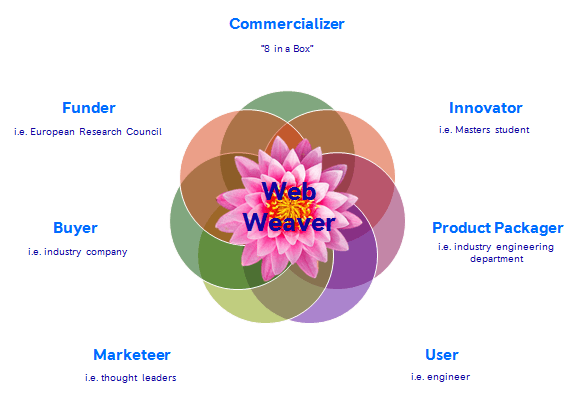
The core methodology is Value Network Analysis (VNA). Value Networks are sets of roles, interactions, and relationships generating economic, social, or environmental value from the perspectives of intellectual capital (internal structure, external structure, and competence) and financial capital (when all elements of intellectual capital interact effectively). Any purposeful organization can be understood as a value network. The specific purposeful network of interest is the innovation web. An innovation web is an evolutionary form of innovation zone. The underlying philosophy of VNA has its roots in Exchange Theory. It is a social psychological and sociological perspective that explains social change and stability as a process of negotiated exchanges between parties. This approach to VNA departs from mainstream exchange theory, by linking the network to both financial and non-financial performance and asset generation for the network overall and at the level of individual roles and both tangible and intangible transactions. Research has continuously demonstrated that value networks can be effectively used to understand the true nature of collaboration.
The core concept of roles is related to the actual behaviour of individuals in a network. In an innovation web these roles are typically:
- Buyer: Interested in achieving the value proposition expected by the Funder.
- Commercializer: Primarily serves the commercialization web. Interested in putting the required commercial and legal agreements in place along with ensuring their compliant operation.
- Funder: Interested in defining the value proposition of the investment.
- Innovator: Primarily serves the research / exploration web. The originator of the “idea”.
- Marketeer: Primarily serves the community building web. Interested in creating a “coalition of the willing” with relevant self-organizational behaviours along a shared purpose.
- Product Packager: Converts the “idea” into a product for the User.
- User: Primarily serves the market validation web. Applies the “idea” to a challenge in order to achieve the value proposition.
- Web Weaver: Serves the (overall) web in order to help achieve the shared purpose.
The role of Web Weaver is an overarching role facilitating the network as a whole. Roles can be filled by individual participants, teams or subgroups, business units, organizations, collectives or aggregates, communities, cities or regions, nation-states and / or other networks. Exchanges can be tangible or intangible. Tangible transactions involving goods, services, or revenue, including but not limited to: physical goods, services, contracts, and invoices, return receipts of orders, requests for proposals, confirmations, or payments. Knowledge products or services that directly generate revenue, or that are expected (contractual) and paid for as a part of a service or good (such as reports or package inserts) are also considered as tangible exchanges. Also important to recognize is that intangible knowledge and information exchanges that flow around and support the core product and service value chain, but are not contractual.
Value network discovery and facilitation are based on principles of systemic and inductive inquiry which accepts the messiness of “living systems”, and chooses to see innovation systems as such systems. More particularly it accepts the need for personal sense making stemming from conscious search regarding patterns and choices in the (living innovation) system.
Key value network archetypes in the innovation web evolution are (a) the research web (b) the socialization web (c) the market validation web (d) the commercialization web and (e) “transition” webs, which exist between each of the previously mentioned archetypes and are responsible for the transformation between the different innovation web stages.
Value Networks are visualized, analysed and served using holomaps for guidance. The below sequence of images provide a high level view of the evolution of the innovation web archetypes evolution. Key roles are shown in the circular shapes; tangible value is transacted from one role to the next as shown by green solid arrows, while intangible value is transacted from one to the next as shown by blue dotted arrows.
Exploring the First Innovation Web: The Research Archetype
The research web archetype is a web of relationships with the primary focus on research and innovation exploration. The innovator is the originator of the “idea”. The user applies the “idea” to a challenge they face. Upon achieving the threshold values for key performance indicators the facilitated transition to the next web archetype called “Socialization” can be launched. More details and animation at https://open-european-innovation-network.blogspot.com/2019/06/exploring-first-innovation-web-research.html.
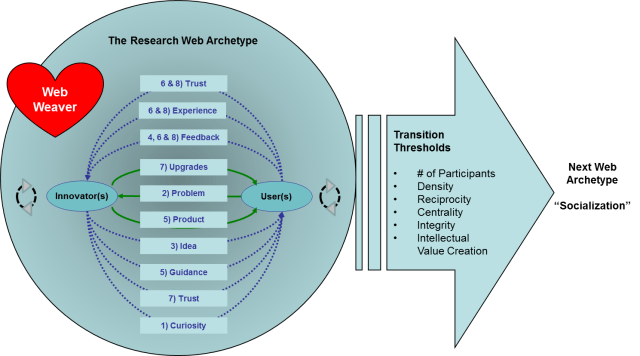
Exploring the Second Innovation Web: The Socialization (Community Building) Archetype
The socialization web archetype is a web of relationships, which evolves out of the research web archetype as the innovation crystalizes and begins reaching early stage practitioners / evangelists in organizations. The research web archetype continues to “operate”. More details and animation at https://open-european-innovation-network.blogspot.com/2019/06/exploring-second-innovation-web.html.
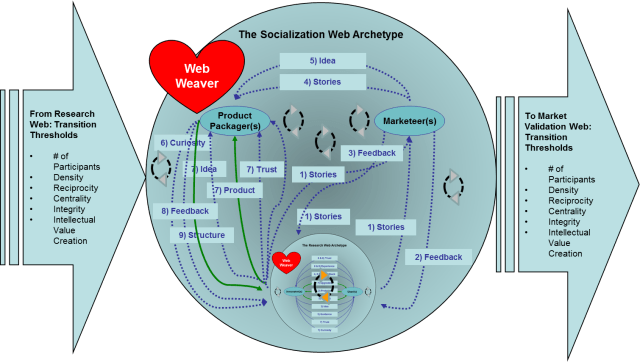
Exploring the Third Innovation Web: The Market Validation Archetype
The market validation web archetype is a web of relationships that evolves when the product or the result is clear, and the goal of the network is to test and validate market or beneficiary readiness. It logically builds on the results of efforts conducted by a previous community building web archetype. The research web and the socialization archetypes continue to “operate”. More details and animation at https://open-european-innovation-network.blogspot.com/2019/06/exploring-third-innovation-web-market.html.
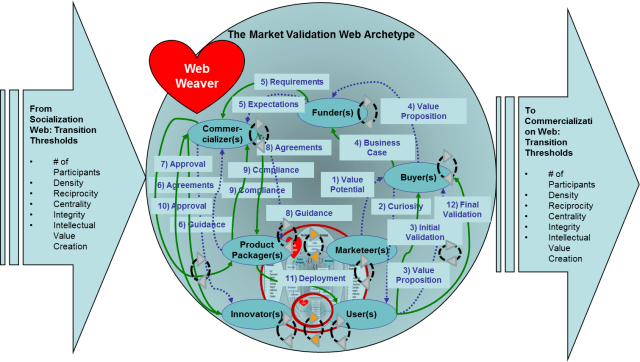
Exploring the Fourth Innovation Web: The Commercialization Archetype
The commercialization web archetype involves bringing the product or result to the market through production and distribution. The research, socialization, and market validation web archetypes continue to “operate”. More details and animation at https://open-european-innovation-network.blogspot.com/2019/06/exploring-fourth-innovation-web.html.
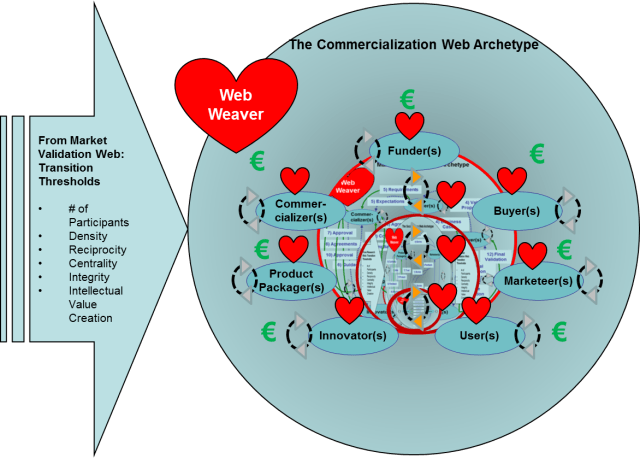
Exploring Nested Archetypes
All innovations webs are “nested” in each other whereby as they mature, they become more and more focused. Each represents a complex adaptive system and the “whole” requires intensive facilitation efforts.
